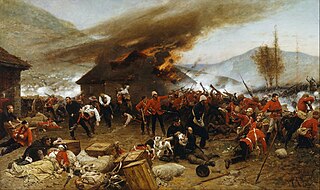
The Battle of Rorke's Drift, also known as the Defence of Rorke's Drift, was an engagement in the Anglo-Zulu War. The successful British defence of the mission station of Rorke's Drift, under the command of Lieutenants John Chard of the Royal Engineers and Gonville Bromhead, of the 24th Regiment of Foot began once a large contingent of Zulu warriors broke off from the main force during the final hour of the British defeat at the day-long Battle of Isandlwana on 22 January 1879, diverting 6 miles (9.7 km) to attack Rorke's Drift later that day and continuing into the following day.

Elizabeth Southerden Thompson, later known as Lady Butler, was a British painter who specialised in painting scenes from British military campaigns and battles, including the Crimean War and the Napoleonic Wars. Her notable works include The Roll Call, The Defence of Rorke's Drift, and Scotland Forever!. She wrote about her military paintings in an autobiography published in 1922: "I never painted for the glory of war, but to portray its pathos and heroism." She was married to British Army officer William Butler, becoming Lady Butler after he was knighted.

Lieutenant-Colonel Anthony William Durnford was an Irish career British Army officer of the Royal Engineers who served in the Anglo-Zulu War. Breveted colonel, Durnford is mainly known for his defeat by the Zulus at the Battle of Isandlwana, which was a disaster for the British Army.

William Jones was a British recipient of the Victoria Cross for his action at the Battle of Rorke's Drift in January 1879, the highest and most prestigious award for gallantry in the face of the enemy that can be awarded to British and Commonwealth forces.

Zulu is a 1964 British epic adventure action war film depicting the Battle of Rorke's Drift between a detachment of the British Army and the Zulu in 1879, during the Anglo-Zulu War, in which 150 British soldiers, 30 of whom were sick and wounded, at a remote outpost, held off a force of 4,000 Zulu warriors.
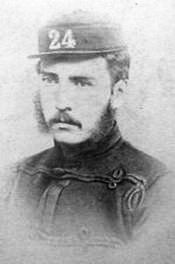
Major Gonville Bromhead VC was a British Army officer and recipient of the Victoria Cross, the highest award for valour in the face of the enemy that can be awarded to members of the British armed forces. He received the medal for his part in the defence of Rorke's Drift in January 1879, in which a small British garrison of 139 soldiers successfully repulsed an assault by some 4,000 Zulu warriors. Bromhead was portrayed by Michael Caine in the film Zulu, which depicted the battle.

Colonel John Rouse Merriott Chard was a British Army officer who received the Victoria Cross, the highest military decoration for valour "in the face of the enemy" that can be awarded to members of the British armed forces. He earned the decoration for his role in the defence of Rorke's Drift in January 1879 where he assumed command of the outpost and a small garrison of 139 soldiers and successfully repulsed an assault by some 3,000 to 4,000 Zulu warriors. The battle was recreated in the film Zulu in which Chard was portrayed by Stanley Baker.

William Wilson Allen, VC was an English recipient of the Victoria Cross (VC) for his actions at the Battle of Rorke's Drift in January 1879, the highest and most prestigious award for valour in the face of the enemy that can be awarded to British and Commonwealth forces.

Christian Ferdinand Schiess VC was a Swiss recipient of the Victoria Cross, the highest and most prestigious award for gallantry in the face of the enemy that can be awarded to British and Commonwealth forces. He died in poverty at just 28.
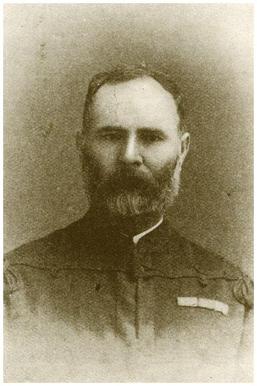
James Langley Dalton VC was an English recipient of the Victoria Cross, the highest and most prestigious award for gallantry in the face of the enemy that can be awarded to British and Commonwealth forces for service at the Battle of Rorke's Drift during the Anglo-Zulu War.
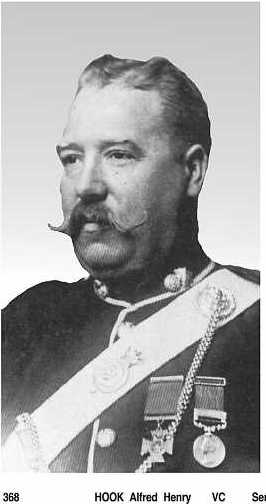
Alfred Henry "Harry" Hook VC was an English recipient of the Victoria Cross, the highest and most prestigious award for valour in the face of the enemy that can be awarded to British and Commonwealth forces, for his actions at the Battle of Rorke's Drift.

Frederick Hitch, VC was an English recipient of the Victoria Cross for his actions at the Battle of Rorke's Drift, the highest award for gallantry in the face of the enemy that can be awarded to British and Commonwealth forces.

Lieutenant-Colonel James Henry Reynolds VC, born Kingstown, County Dublin, Ireland was an Irish recipient of the Victoria Cross for his actions at the Battle of Rorke's Drift, the highest and most prestigious award for gallantry in the face of the enemy that can be awarded to British and Commonwealth forces. He was educated at Castleknock College and Trinity College, Dublin.

The South Wales Borderers was a line infantry regiment of the British Army in existence for 280 years.
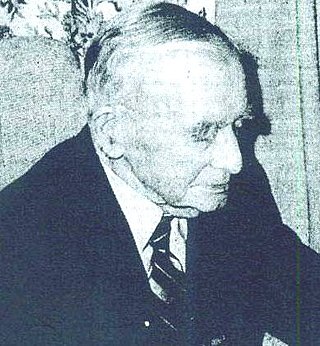
Canon William Murrell Lummis MC was a British military historian most noted for the research he conducted on the Victoria Cross, the Charge of the Light Brigade, and Rorke's Drift.

The Natal Native Contingent was a large force of auxiliary soldiers in British South Africa, forming a substantial portion of the defence forces of the British colony of Natal. The Contingent saw action during the 1879 Anglo-Zulu War. The Natal Mounted Police was created in 1873 to bolster the defenses of Natal. It enlisted European officers, NCOs and natives. The infantry was created in 1878. Most enlisted troops were drawn from the Basuto and Mpondo tribes, which had had long experience fighting the Zulus.

'Padre' George Smith, an army chaplain, was a defender of Rorke's Drift during the Zulu War of 1879, an action which saw the awarding of eleven Victoria Crosses.

The Regimental Museum of The Royal Welsh, formerly the South Wales Borderers Museum, is located at Brecon in Wales. The museum's collection is made up of artefacts collected from a variety of sources from around the world and which display the regiment's 300-year history.
Gert Wilhelm Adendorff was a member of the Natal Native Contingent notable for being the only soldier on the British side present at both the Battle of Isandlwana and the Battle of Rorke's Drift during the Anglo-Zulu War of 1879 made memorable in the film Zulu (1964).

















